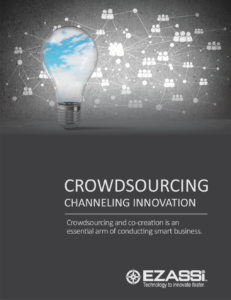
What is Crowdsourcing for Innovation?
What is Crowdsourcing for Innovation?
Crowdsourcing and co-creation is an essential arm of conducting smart business.
How to channel your internal and external crowd for innovation, ideation and collaboration.
Bringing new ideas to life isn’t just about boardroom brainstorming or relying on a small circle of experts. In fact, some of the most successful organizations have looked outward, directly to their customers or broader audiences, to spark exciting innovations. A popular and effective approach is to invite valued customers to collaborate in updating an existing product or inventing something entirely new. This can take the form of a contest, where participants submit ideas and, in some cases, the best suggestions win a prize. Consider Lay’s “Do Us a Flavor” campaign, where consumers dreamt up and named new potato chip flavors, some of which even ended up on store shelves. These types of crowdsourcing initiatives not only generate a wealth of creative ideas but also foster a sense of community and engagement around your brand.
What is the Goal of Crowdsourcing Innovation?
 By harnessing the collective creativity of the crowd, you can exponentially increase the number of solutions that are submitted in response to a certain challenge. More ideas mean a better chance of bringing something truly innovative to the surface. Crowdsourcing for innovation also creates a space for unique collaborations and meetings of the mind that might not occur otherwise. These connections, among experts, customers, employees and crowd members from all over the world, allow innovation to be placed at the forefront.
By harnessing the collective creativity of the crowd, you can exponentially increase the number of solutions that are submitted in response to a certain challenge. More ideas mean a better chance of bringing something truly innovative to the surface. Crowdsourcing for innovation also creates a space for unique collaborations and meetings of the mind that might not occur otherwise. These connections, among experts, customers, employees and crowd members from all over the world, allow innovation to be placed at the forefront.
When organizations tap into the wisdom of the crowd, they’re not just seeking answers, they’re inviting the energy, ingenuity, and fresh perspectives that emerge when diverse individuals solve problems together. This belief in “knowledge in numbers” often yields results that far surpass what a single expert could achieve in isolation.
Consider hackathons: marathon sessions where programmers, designers, and thinkers from all walks of life come together, sometimes virtually, sometimes in bustling rooms, to tackle challenges or rapidly prototype new solutions. Similarly, crowdsourcing initiatives in scientific research, such as enlisting citizen scientists for data collection, have proven invaluable for gathering insights at unprecedented scale.
Ultimately, it’s not just the quantity of ideas that matters, but the collaborative spark and momentum that only an engaged crowd can generate. Whether it’s a global hackathon or an online community pooling their wisdom, this collective approach continues to drive breakthrough innovation across industries.
Who Can be in My Crowd?
Anyone. The choice is yours. While companies tend to turn to their own employees first when they are looking for innovative new ideas, crowdsourcing is about getting the most out of your internal network while also connecting with external resources. That means that your crowd can consist of employees, partners, researchers, suppliers, customers and experts from all over the world. You can set up specific communities or remove all boundaries and limitations for completely open innovation. With crowdsourcing innovation, you are in complete control of who you want to include in your crowd.

Laying the Groundwork: Setting Up Your Crowdsourcing Initiative
Every successful crowdsourcing effort begins with thoughtful preparation. Before you send out a call to your crowd, take the time to clearly define what you’re hoping to achieve. Identify the challenge or opportunity at hand—be as specific as possible with your goals. Are you looking for a groundbreaking product idea, a solution to a technical issue, or creative input for a marketing campaign?
Next, consider what type of crowdsourcing best suits your needs. There are various approaches—open calls for ideas, targeted challenges within specialized communities, or collaborations that blend internal expertise with fresh external perspectives.
Ask yourself:
- What outcome do we seek? (E.g., product concepts, process improvements, customer insights)
- Who should participate? (Employees, customers, industry experts, the general public)
- How will we evaluate and act on the responses?
By taking the time up front to map out your goals, the makeup of your crowd, and how you’ll manage the process, you’ll set the stage for a crowdsourcing initiative that is both efficient and impactful.
How Do Businesses Rely on Crowdsourcing?
Crowdsourcing relies on a simple, yet powerful idea: the more people who put to work on solving a problem, the better the chances of a positive outcome and an innovative solution. Traditionally, businesses have held their cards close to their chest and remained hesitant to share or discuss their projects. While there might have been a time when this approach worked to keep competition at bay, in our modern business world, working in isolation actually makes businesses more vulnerable to be left behind as innovation moves at an ever-quickening pace. Crowdsourcing represents the future of innovation, ideation and collaboration.
Today, businesses have realized that opening innovation to a designated crowd can actually accelerate innovation, making them more competitive. Instead of remaining insular and running the risk of creating an environment where employees feel limited by the confines of their position, companies are tearing down walls, empowering existing employees and tapping into the creative power of the crowd.
This shift isn’t just about expanding the idea pool; it’s also about building trust and transparency within organizations. When crowdsourcing is used internally, it can improve company culture and spark positive, disruptive change. Inviting employees to share feedback on how the organization can become more innovative, inclusive, or efficient is a trust exercise in itself. It’s crucial not just to gather these insights, but to listen, acknowledge, and act on them. Sharing results with leadership and the broader team shows employees their voices matter, further fueling engagement and a sense of ownership in the innovation process.
By harnessing both internal and external perspectives, businesses foster an environment where creativity thrives and every team member feels empowered to contribute to the organization’s growth.
What Steps Should an Organization Follow to Implement Crowdsourcing Successfully?
Successfully integrating crowdsourcing into your organization requires more than just opening the virtual doors and hoping a flood of fresh ideas rolls in. Like any strong business initiative, a little thoughtful planning goes a long way. Here’s how to pave the way for a thriving crowdsourcing effort:
1. Clearly Define Your Objective
Begin by zeroing in on the specific challenge you’re trying to solve. Take the time to outline what kind of ideas or solutions you’re seeking and which areas of your business you want to impact, whether it’s streamlining processes, unearthing disruptive innovations, or simply improving the everyday. You’ll also want to decide who should be invited to participate: your internal team, customers, partners, or the wider public.
2. Structure the Approach and Incentives
Consider how you’ll structure the crowdsourcing initiative. Will it be a competition, a call for open suggestions, or a collaborative challenge with staged phases? Incentivize participation thoughtfully, rewards could include monetary prizes, public recognition, exclusive experiences, or professional opportunities. Establish eligibility criteria and make the rules of engagement transparent from the outset.
3. Get the Word Out
Awareness is key to participation. Promote your initiative through targeted channels like email campaigns, internal company platforms, online communities, and all your relevant social networks. Encourage sharing to broaden your reach and consider offering additional incentives for referrals or social engagement. The more accessible and visible your campaign, the better your chance of attracting diverse, high-quality contributions.
4. Facilitate Engagement and Provide Feedback
Once ideas begin pouring in, keep the crowd motivated with ongoing updates and open communication. Acknowledge contributions and let participants know their ideas are being taken seriously. For internal initiatives, close the loop by sharing outcomes or next steps with your team, demonstrating that employee feedback isn’t just collected and forgotten, but actively shapes the future of the organization
By thoughtfully guiding your crowdsourcing efforts with clarity and openness, you’ll foster a culture that welcomes innovation from every direction—and position your business to capture ideas that may otherwise have never come to light.
What Are Some Real-World Examples of Crowdsourcing in Action?
Crowdsourcing takes many forms across different industries, with businesses crafting creative ways to tap into the collective insight and enthusiasm of the public, customers, and even their own teams.
- Hackathons and Code Sprints: Tech companies frequently gather programmers, designers, and other problem-solvers from around the globe for hackathons, intense collaborative events designed to rapidly develop solutions or improve products within a short window. These events not only generate fresh ideas but also foster energetic collaboration and unexpected partnerships.
- Citizen Science Initiatives: Scientific organizations often reach beyond their walls to invite citizen scientists, enthusiastic volunteers with various backgrounds, to collect, process, or analyze data. Whether it’s tracking migratory birds, weather patterns, or even exploring images from space, this kind of involvement leverages the sheer scale and diversity of the crowd to accelerate research.
- Open Product Design and Creation: Some brands engage their audiences by encouraging them to submit ideas for new products or improvements to existing ones. These initiatives might take the form of contests, with winning suggestions brought to market and celebrated publicly. Not only does this provide a steady stream of innovative concepts, but it also fosters a sense of community around the brand.
- Crowd Voting: When it comes to making big decisions, like naming a product or even deciding a sports team’s new mascot, organizations sometimes turn the process over to the crowd. Opening the floor to public votes ensures that the end result resonates with the core audience and sparks valuable engagement.
These examples all demonstrate the vast potential of crowdsourcing: energizing collaboration, uncovering untapped ideas, and driving innovation far beyond the limits of a traditional team.
 Absolutely. If you aren’t crowdsourcing innovation, you can be sure that your competitors are. That means that they are actively pursuing innovation using a powerful tool that harnesses resources from all over the world. No matter how talented your existing team might be, it is impossible to keep up with that kind of approach.
Absolutely. If you aren’t crowdsourcing innovation, you can be sure that your competitors are. That means that they are actively pursuing innovation using a powerful tool that harnesses resources from all over the world. No matter how talented your existing team might be, it is impossible to keep up with that kind of approach.
Even if your team is developing great ideas, your competitors will be able to bring them to market faster, which means that your next big idea might have been stolen right from under your feet. You will be back at the drawing board while your competitors are winning a bigger share of the market. Crowdsourcing is about innovation and ideation, but it is also about acceleration and the ability to move ideas through the development process even faster.
Crowdsourcing Innovation Software
Crowdsourcing innovation software can provide an essential tool that allows businesses to harness the power of crowdsourcing and allow participants to effectively share, rate and develop ideas through a centralized platform.
Whether you’re deciding on a name for a new product, selecting features for your next release, or even choosing a direction for your brand, crowd voting provides a structured way to capture the opinions of those who matter most to your organization. For example, when the Washington Redskins NFL team pursued a new identity, they turned to their fans for input, allowing them to participate directly in the rebranding process by choosing from a shortlist of names.
Features and Benefits of Ezassi Crowdsourcing Innovation Software
- Ability to create both branded and unbranded/confidential challenges
- Rewards, points and gamification for increased user engagement
- User profiling and advanced search functionality
- Live chat with users and save to the project or community
- Cyberscouting seeks out top-talent to participate in challenges
- Automated emails and alerts
- Network and crowdsourcing management
- Automated scoring for idea submissions based on pre-determined criteria
- Internal and external idea capture
- User-friendly idea collaboration tools
- IP protection
- Powerful analytics
- And much more
Incentivize Participation and Drive Engagement
One of the most effective ways to boost participation and build genuine excitement in your crowdsourcing campaigns is through incentives. Whether it’s cash prizes, tangible rewards, or creative recognition, establishing clear incentives motivates people to go the extra mile and submit their best ideas. Before launching your next challenge, decide on the reward structure and eligibility criteria, this upfront clarity sets the stage for greater engagement and a more dynamic innovation pipeline.
By combining these robust features with thoughtful incentives, businesses can foster a thriving community of innovators. The software’s built-in rewards, gamification, and advanced collaboration tools make it easy to encourage participation, capture high-quality ideas, and keep momentum strong from start to finish.
Technology Landscaping for Crowdsourcing Innovation
Perhaps one of the most impressive aspects of the Ezassi Innovation Software is Technology Landscaping, which allows businesses to mine data and use powerful analytics. This information can be used to:
- Run sophisticated searches to unearth new and emerging technologies
- Crawl the entire digital universe to discover disruptive solutions and identify talented innovators
- Cyberscout talent based on a variety of criteria
- Identify and analyze trends in order to make smart business decision and focus efforts
- Understand what competitors are working on and pursuing
Essentially, crowdsourcing software makes it easy for companies to participate in crowdsourcing and create a culture of innovation that drives progress.
The information age can be a double-edged sword. While companies are able to enjoy access to limitless amounts of data, digesting and understanding all of that information can be overwhelming and impossible. With Technology Landscaping, businesses can drill-down to the information that matters and stay on top of the latest trends, technology and innovators.
How Crowdfunding Works in the Innovation Landscape
Crowdfunding has emerged as a dynamic approach to raising capital, harnessing the collective power of the crowd to finance new ideas and ventures. The basic premise is simple: instead of seeking a sizable investment from one or two sources, you open the door to a broad audience, inviting hundreds or even thousands of people to contribute smaller amounts to support your project.
This model thrives particularly well for innovative concepts and early-stage products, as it allows entrepreneurs to gauge public interest while securing the necessary resources to move forward. Crowdfunding platforms act as the stage on which inventors and creators can showcase their proposals, outline their vision, and directly engage with potential supporters.
Some of the most well-known platforms in this space include:
- Kickstarter: Often associated with creative projects, from tech gadgets to board games.
- Indiegogo: Offers flexibility for campaigns across industries, supporting everything from eco-friendly products to social initiatives.
- GoFundMe: Popular for personal causes but also used for community-driven innovation.
Supporters of these campaigns are typically rewarded for their contribution, whether that’s a first-run product, exclusive access, or a simple thank-you. For many startups and inventors, crowdfunding does more than just provide funding; it helps validate the market, build an enthusiastic early community, and generate buzz before a product even hits the shelves.
What Businesses Should Crowdsource Innovation?
Crowdsourcing innovation can serve as a flexible, scalable and completely adaptable tool that is perfect for any business that is looking to better understand the market, generate new products, improve processes and identify creative solutions. This makes it perfect for practically any industry and any size business. However, companies who work in fast-paced industries that are driven by innovation may have the most to gain from Ezassi and crowdsourcing innovation.
Cybersecurity, healthcare, pharmaceutical, consumer packaged goods, financial, and technology companies have all used Ezassi to gain a competitive edge and seek innovative solutions beyond their internal network. These industries tend to be under greater pressure to continuously provide new solutions and work at a faster pace. Ezassi allows these types of companies to be their best and continue to cultivate a culture of innovation.
Innovation is a must, but it can also be a daunting challenge to companies who are at a loss for where to begin. Crowdsourcing innovation can breathe new life into your existing team and open the door to a free exchange of ideas that has the potential to uncover truly disruptive solutions. With the help of Ezassi Innovation Software, crowdsourcing innovation can be easier than you might think. You can issue challenges, create specific communities, use Technology Landscaping to uncover vital information and push solid ideas through the development process.
Ezassi has innovative solutions for crowdsourcing new ideas and technologies to implement incremental, adjacent, and transformational successes for your business.



